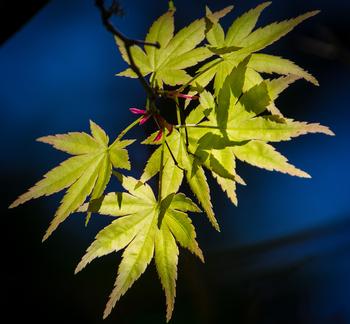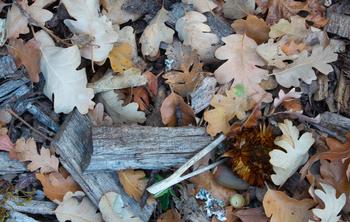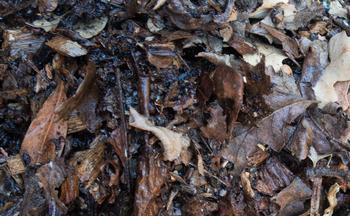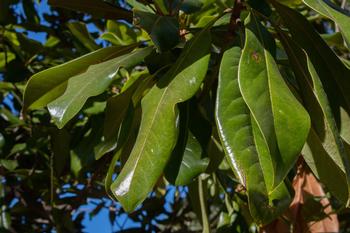Autumn’s treasure of leaves
-
Karen Gideon
-
One of the most important organs of a plant’s anatomy is the leaf. The leaf is an energy manufacturing plant where photosynthesis and transpiration take place. The small stomas of the leaf act as regulators in the exchange of oxygen, carbon dioxide, and water. The contracting action of the stoma affects the flow of water and nutrients from the roots to limb and leaf and the path of glucose and nutrition from the photosynthesizing leaves to the rest of the plant. Water and food are stored in the leaves, making them rich in minerals, protein, and sugars.
 Leaves use carbon dioxide in the air, water from the soil, and energy from sunlight to make sugars through photosynthesis. Photo: Karen Gideon
Leaves use carbon dioxide in the air, water from the soil, and energy from sunlight to make sugars through photosynthesis. Photo: Karen GideonCome fall, many trees and shrubs shed their leaves, dropping them to the ground in the expectation that they will decompose and share their nutrients, enriching the soil with fungi and bacteria and mulching the base of the plant. As mulch, fallen leaves help protect the plant from winter’s assault by spreading an organic blanket on the surface of the soil. They help prevent the drying and freezing of root tissue. They suppress weed growth and provide a habitat for insects, larvae, and other animals seeking shelter, food, and a place to nest. When rainstorms come, leaves help with erosion control.
This nutritive blanket can be a conundrum for the gardener because leaf litter can also be a liability. Fallen leaves are dry and combustible, subject to fire and smolder from a spark. We are all working to create defensible space in our landscape to protect our homes from wildfire. The effort to clear the combustible material can include the removal of this valuable nutritive blanket. What is a gardener to do? Dried leaves are combustible and should be removed from the area up to five feet from structures. Photo: Karen Gideon
Dried leaves are combustible and should be removed from the area up to five feet from structures. Photo: Karen GideonYou can still leverage the nutritive value that your dead leaves deliver through leaf composting. This need not require a separate composter or fancy system. Rather, piling the leaves on the ground in an area of your yard at least thirty feet from your home (Zone 2) and away from other vegetation allows them to break down without being a fire hazard. If the thought of raking leaves away from your home for safety is more than you can bear, consider using a reverse blower. This leaf vacuum with a bag collects your leaves with the effort it takes to walk your yard. Review Fire Smart basics at https://ucanr.edu/sites/MarinMG/files/356387.pdf.
Understanding the basics of decomposition can help you keep your compost pile growing and ready for use around the base of your plants. The objective of composting is to balance nitrogen and carbon into a nutritious plant food and soil enhancer. This can be achieved by combining the carbon in your dried leaves with material high in nitrogen. These “green” materials can include chicken manure, coffee grounds, grass clippings, and raw vegetable scraps. Look to add the green composting materials to the leaves in four-parts leaves to one-part green material ratio for best results. Decomposed leaves, combined with green material, offer nutrition and soil enhancements to the garden. Photo: Karen Gideon
Decomposed leaves, combined with green material, offer nutrition and soil enhancements to the garden. Photo: Karen GideonThe decomposition process requires moisture and oxygen for the best results. The pile of compost should be turned and mixed. Moisture can be provided by rain or hand sprinkling. If the pile becomes slimy or smelly, add more leaves.
The type of leaf added to the pile can affect the quality of the compost. Hard, waxy leaves like magnolia and live oak leaves break down slowly and benefit from shredding or weed whacking. If you’re using oak leaves, you may want to limit their quantity to twenty percent of the mix due to their acidic nature. Avoid adding meat, dairy products, or cooked food – it can attract critters. And don’t add dog or cat poop – your pile might become a source of dangerous bacteria. Leaves with thick, waxy tissue will break down faster when shredded or chopped up with a weed whacker. Photo: Karen Gideon
Leaves with thick, waxy tissue will break down faster when shredded or chopped up with a weed whacker. Photo: Karen GideonThe number one priority is to remove leaves in the area within five feet of your home and other structures or decks. If you can accommodate a compost pile in an extended reduced-fuel area, you can still use the valuable leaves in your garden.




